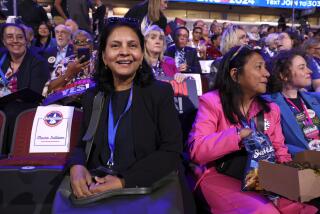For Indian Americans, TV channels offer a taste of the old country
- Share via
Every evening, millions of families in India gather around their TV sets to watch “Balika Vadhu,” a soap opera about a married 8-year-old girl. At the same time, Indian households in the U.S. that have access to it switch to Appka Colors on the Dish Network to catch the child-bride saga, weighing in with their friends and relatives in India on online message boards.
That connection between immigrants here and their relatives back home was a key consideration when Colors, the highest-ranked general entertainment channel in India, launched in the U.S. this year. Reaching 40 million households in India, the 2-year-old channel, a joint venture between Viacom and Indian media conglomerate Network 18, is hoping to replicate some measure of that success stateside.
“Once we gathered critical mass in India, we believed that the viewership patterns of those who migrated to the U.S. were similar,” said Rajesh Kamat, chief operating officer of Mumbai-based Colors.
In January, Colors linked with Dish; it is now part of a Hindi language paid-subscription package on the satellite service. “People here had heard through word of mouth from those in India about Colors,” said Chris Kuelling, vice president of international programming for Dish, which first began broadcasting Hindi programming in the U.S. more than a decade ago. “And those who now have it seem to be very pleased with it.”
Colors is among the latest to join the growing roster of programming directed toward Indians, a demographic that ranks among the most highly educated immigrant populations in the country. According to the U.S. census, the Indian American population in the country was 1.7 million in 2000, a figure that had doubled since 1990, and is likely to have doubled again. The largest concentration is in California, followed by New York, New Jersey, Illinois and Florida. The majority are college graduates. They have the highest per capita income of immigrant populations. Advertisers appealing to the demographic include Citibank, State Farm, Vonage and Metlife, which create ads specifically for the market.
As a result, just about every cable and satellite provider offers Hindi-language channels and a growing diet of varied programming. Industry executives decline to reveal numbers, but estimate that at least one third of South Asian households in the U.S. subscribe to some type of entertainment package.
Showbiz India, a weekly, hourlong show which started 12 years ago (channel 18 in the Los Angeles area), was the first television resource for Indians and some other South Asians. “We were around before the advent of the other platforms, but there is clearly enough demand for this kind of programming that we are all co-existing,” said Reshma Dordi, the show’s founder and host. She says she is often stopped in the streets by non-South Asians who tune in for the music videos, interviews with visiting Bollywood stars and features about Bollywood productions.
“We’re seeing a real flowering in demand,” said David Jensen, vice president of content acquisition for Comcast. The cable operator provides eight South Asian linear channels — among them SET Asia ( Sony), Zee TV and STAR India PLUS — in Northern California but is looking to expand its reach into other parts of the country this year. A new platform providing some 90 ethnic channels will include 10 targeted toward Indians. Comcast also carries “Bollywood Hits on Demand” nationwide.
The rise in population numbers, awareness and demand has dovetailed with increased technical capacity, he said. “Those in programming will be asking, ‘What can we do with all this new bandwidth?’ And the two areas that stand out are Bollywood and the Hispanic community,” he said.
Executives say that the nature of the programming is poised to change, taking into consideration U.S.-born Indians whose tastes are more inclined toward mainstream American television. According to Jensen, that could offer opportunities for programming for children as well as sports shows.
And although the old favorites remain — Bollywood movies, music videos, long-running soap operas, news shows — reality programming is also beginning to emerge. Colors in India has created Indian versions of “Fear Factor” and “Big Brother.”
“The question was, ‘How well can you add the flavor of curry to it and retain the essence of the shows?’” Kamat said. For “Fear Factor,” Colors enlisted Bollywood action star Akshay Kumar and romantic comedy actress Priyanka Chopra as hosts, and populated its contestants with national cricketers (in the U.S., that would be akin to having Matt Damon and Katherine Heigl host and NBA stars performing the stunts).
“The first-generation South Asian community is very attached to the programming they’re used to. There’s a great deal of nostalgia for them,” said Scott Wheeler, senior vice president of network development for International Media Distribution, part of Comcast. But as technology improves, he said, there could be more variety.
Kamlesh Patel, a consultant specializing in the South Asian market, agrees that the way forward is to change the type of programming. “For the first-generation Indians, what works in India works in the U.S. They are used to the routine soap opera dramas. But third-generation U.S.-born Indians are not going to find that interesting. They were brought up on a staple diet of NFL and NBA programming, action movies and thrillers. What they will want may have to have the same level of sanitation (as Hindi programming), but perhaps with a little greater adventure.”
More to Read
Sign up for Essential California
The most important California stories and recommendations in your inbox every morning.
You may occasionally receive promotional content from the Los Angeles Times.










